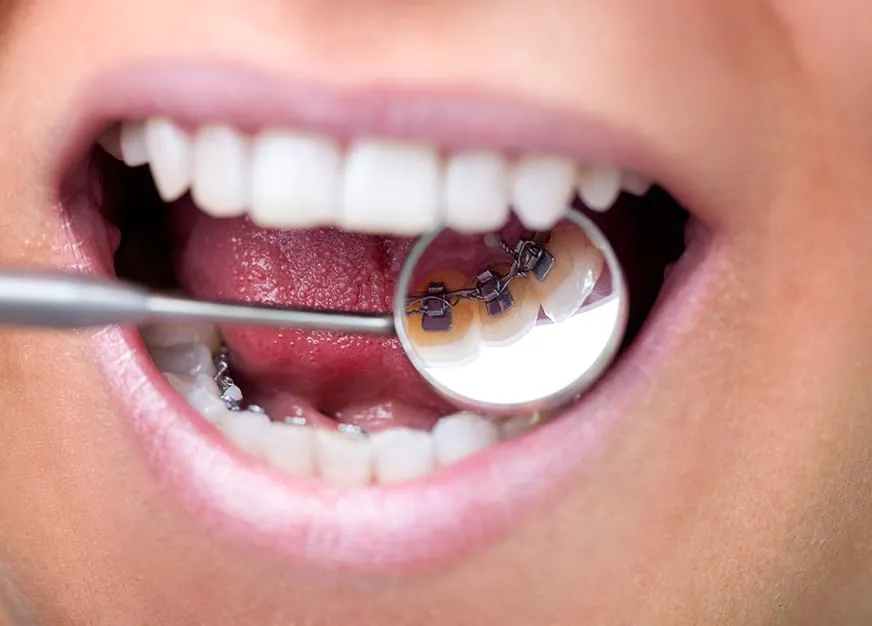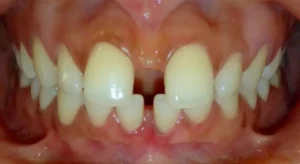What are Lingual Braces?
These things, also known as invisible braces, are a type of orthodontic device. They are similar to metal braces. However, they are placed on the inner side of the teeth. This makes them less visible than traditional braces.
These things have metal brackets and a thin wire. An orthodontist adjusts them to straighten the teeth. This method is effective and discreet. The benefits of lingual braces include their invisibility and efficiency in aligning teeth.
How Are Lingual Braces Applied?

The lingual appliance requires brackets fixed to the teeth using bonding glue, all connected by a flexible metal archwire.
When visiting the orthodontist for lingual brace treatment, they will create detailed replicas of your teeth. This is done through either traditional putty molds or advanced digital imaging techniques.
They use these impressions to design the customized brackets used in lingual braces. The impressions are sent to a lab, which creates the brackets. It usually takes about 4-6 weeks to make and send back the brackets to your orthodontist.
these things are trickier to attach than traditional braces because they go behind your teeth. The orthodontist uses a special design to place all the brackets at once, unlike the one-by-one method used for regular type of braces.
How Much Do Lingual Braces Cost?

these things, offered by Diamond Braces, typically cost between $10,000 and $13,000. This higher price is due to several factors.
First, they require orthodontists to have specialized training, which not all practitioners possess. Second, these things are custom-molded to each patient’s teeth using more expensive materials. Additionally, they are less common than traditional braces, leading to fewer patients and higher costs per case.
Patients choose these things for their discreet placement on the inner side of the teeth. However, the cost of lingual braces at Diamond Braces can be a concern.
These things often take longer to work than traditional braces, adding to the cost. Moreover, they may not be fully covered by dental insurance. It’s advisable to discuss with your insurance provider about potential coverage for a portion of the these things cost.
The cost associated with these things reflects all of the above factors: while you are paying more for them, you are also getting a uniquely customized treatment with a more discreet appearance. The price range encompasses all materials, orthodontic appointments, and subsequent care, but retainers might incur additional charges.
Lingual Braces vs Traditional Metal Braces

Lingual braces use technology similar to traditional braces. The main difference is in their placement. They are placed on the backside of the teeth, near the tongue. This makes them less visible compared to traditional braces, which are placed on the front of the teeth.
The design of lingual braces is smaller. This often makes them more comfortable for patients. When comparing lingual braces vs traditional braces, the key differences are visibility and comfort due to their unique placement and design.
Locating an orthodontist experienced in lingual braces, a less common treatment option, may require extra effort. After finding a suitable provider, they’ll design a treatment plan tailored to your tooth movements.
Remember, lingual braces, tooth-colored and placed behind your teeth, can be difficult to clean. They might also impact speech and cause tongue discomfort. Maintaining excellent oral hygiene is crucial throughout the treatment.
The duration of treatment with these things aligns with the national average for orthodontic treatments, typically around 24 months. This period may vary based on individual cases and treatment plans.
Lingual Braces vs Traditional Metal Braces Pros & Cons

Pros
- Inconspicuous Design: The brackets are positioned behind the teeth, facing the tongue, making them almost invisible.
- Personalized Treatment: Each set is tailored specifically to the individual’s mouth and orthodontic needs.
- Versatile Effectiveness: Capable of addressing a wide range of orthodontic issues.
- Compact Brackets: The brackets used are notably smaller.
Cons
- Higher Cost: The unique treatment design and materials used can lead to increased expenses.
- Potential Speech Impact: The proximity of the brackets to the tongue might result in a temporary lisp.
- Cleaning Challenges: Maintaining oral hygiene can be more difficult due to the positioning of the brackets.
- Limited Scope: Not all dental conditions can be effectively treated with this method.
- Extended Treatment Duration: This approach might take longer than traditional braces, ceramic braces and could require longer appointments.
- Discomfort Risks: There’s a possibility of experiencing discomfort or pain in the tongue or cheeks.
What Conditions Do Lingual Braces Treat?

Lingual braces are capable of addressing a broad range of dental issues. The customized, discreet design on the inner side of the teeth is effective for achieving straight teeth and beautiful smiles even with significant dental malocclusion.
How do Lingual braces work especially well for correcting dental crowding, crossbites, and underbites. They are a popular choice for orthodontic care.
lingual braces are effective for certain bite types and often yield the desired results. However, they may be less suitable for severe overbites, which can loosen or damage the inner brackets.
Invisalign, another orthodontic appliance, is a viable alternative for straightening teeth. It moves your teeth differently and its treatment time varies with case complexity. Discussing options, including potential monthly payments, with an orthodontic specialist is key for effective treatment.
Who Should Get Lingual Braces?

these things, positioned behind the teeth, offer an effective yet nearly invisible solution for straightening teeth, appealing to older teens and adults who wish to avoid the obvious look of traditional braces. However, they tend to be more expensive, may extend treatment time, and can make cleaning teeth more difficult due to the internal placement of brackets and wires.
If you are getting lingual braces, be prepared for some discomfort in your cheeks and tongue (this guide to braces pain can help), as well as the possibility of impacted speech.





